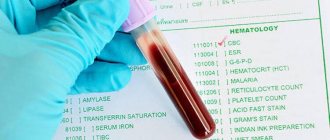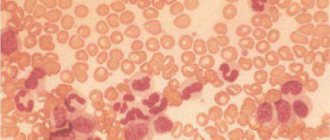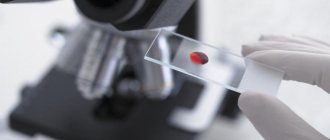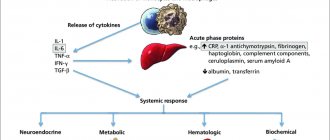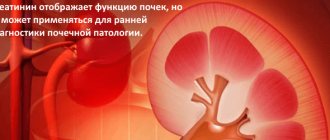When is thrombin time determined?
The purpose of this study is to evaluate the stage of blood coagulation during the fibrinogen activation stage.
Thus, determination of the thrombin time level is prescribed:
- for diagnosing conditions with low levels of fibrinogen in the blood, which are accompanied by a tendency to form blood clots and increased bleeding;
- for liver diseases, such as cirrhosis or tumors;
- when diagnosing miscarriage;
- for the diagnosis of disseminated intravascular coagulation syndrome;
- to assess the risk of thrombosis.
There are a number of pathologies associated with fibrinogen. Thus, its low content in the blood is called hypofibrinogenemia, and when fibrinogen does not perform its functions, despite the normal concentration in the blood, it is called dysfibrinogenemia.
Etiology of indicator violations
An increase in thrombin time can be triggered by myocardial infarction
Thrombin time sometimes has values greater or less than established standards. An increase in time is provoked by the following diseases:
- any form of ARVI or influenza
- tuberculosis
- pneumonia
- cancer formation
- heart attack and stroke
- placental abruption during pregnancy
But there are situations when the thrombin time increases without any abnormalities in the body. For example, in newborns this is a natural process.
Pathologies that reduce thrombin time include:
- Improper liver function or inflammation in the body.
- Lack of vitamins and nutritional components.
- Malignant blood lesions.
- Use of hormonal drugs or anticoagulants.
You can get a specific result about the disease by combining thrombin time analysis with additional methods for diagnosing blood clotting.
Tips for preparing for analysis
Advice for preparing for a thrombin time blood test should be given by the referring physician. The study of the indicator is carried out in blood plasma, which is most often obtained by centrifugation of venous blood.
There is nothing difficult in preparing for this analysis:
- blood should be donated on an empty stomach;
- the day before blood sampling, it is important not to overexert yourself physically;
- eliminate emotional stress the day before the test;
- do not smoke for several hours before going to donate blood;
- talk with your doctor about what medications the patient is taking and whether they may affect the results of the study.
Often, taking anticoagulants leads to an overestimation of the indicator, which disrupts the diagnosis process.
How is the blood sampling procedure performed?
Thrombin time is a rapid test designed to assess the formation of fibrin. The test is performed on a blood sample, which is placed in a tube containing a chemical that prevents clotting. Accurate results are ensured only by proper preparation for the test.
It is recommended to refrain from eating 8-14 hours before the procedure. Before the test, you are only allowed to drink water. 24 hours before the test, do not eat fried or fatty foods. Refrain from drinking alcohol and heavy physical activity. This can distort the data and cause fluid loss in the body, which will lead to blood thickening. 30 minutes before the procedure, do not make sudden movements, try not to worry, and refrain from cigarettes. If you are taking strong medications, wait 7-10 days and then get tested when you stop taking them.
After passing the test, it is advisable not to stand up abruptly or physically disturb yourself. The analysis comes with some risks. These include bleeding, infection, bruising and a feeling of dizziness. When the needle pierces your arm, you may feel a slight burning or pain. Follow the recommendations and the test results will help determine whether your body is healthy. If there are deviations from the norm, proceed with the treatment prescribed by a specialist.
Recommendation! Tell your doctor if you are taking any medications, especially those that affect your blood's ability to clot. Make sure your doctor knows about all the herbs, vitamins, and supplements you take. This includes medications that do not require a prescription and any illegal medications.
Deviation from the norm
If the thrombin time is outside the normal range, then there is a violation in the blood coagulation system at the level of fibrin formation from fibrinogen.
The longer it takes for a clot to form, the greater the chance of bleeding.
Prolongation of thrombin time is observed with:
- taking anticoagulants;
- low fibrinogen levels;
- in cases where fibrinogen is normal, but its quality is “lame”;
- disseminated intravascular coagulation syndrome;
- liver pathologies;
- pregnancy pathologies.
Thrombin time - normal, increase and decrease in the index, causes and symptoms
Blood is the liquid medium of the human body that transports vital elements: oxygen, carbon dioxide, proteins, lipids, carbohydrates. Blood elements perform a protective function, preventing excessive bleeding during injuries.
Attention! The composition of blood includes anucleate, lamellar and white blood cells. Platelets are cells of the hemostatic system involved in the occlusion of damaged vessels. To determine the parameters of hemostasis (blood clotting), a coagulogram is prescribed.
What is thrombin time?
Many people wonder what is thrombin time in a blood test? Thrombin index is a test that measures the time it takes for a clot to form in the affected area. Prothrombin, known as factor II, is just one of the proteins involved in blood clotting.
When an injury occurs, a blood vessel ruptures, causing platelets to collect at the wound site and create a temporary plug to stop the bleeding. To form a blood clot, a series of 12 proteins, or coagulation "factors," cooperate to make a substance called fibrin. Fibrin clogs the vessel, stopping blood loss.
In medicine, there are three successive stages of the conversion of fibrinogen to fibrin:
- Under the influence of thrombin, fibrinogen is converted into a monomer.
- A large polymer, fibrin, is formed from a large number of monomers.
- The polymer produces insoluble fibrin, which clogs the blood vessels.
If deviations are detected when determining thrombin time, this indicates pathology. The indicator can be used in further diagnosis of painful conditions. The thrombin index can be increased or shortened with appropriate treatment.
The hemostatic disorder known as hemophilia causes the body to produce insufficient amounts of coagulation factors. Certain medications, liver disease, or vitamin K deficiency also increase thrombin time.
Symptoms that are inherent in diseases of the blood coagulation system:
- Feeling of "lightheadedness".
- Bleeding that does not stop after applying a tourniquet.
- Severe luteal phases of the menstrual cycle.
- Blood in urine.
- Swollen or painful joints.
- Constant nosebleeds.
If a disorder of the coagulation system is suspected, the doctor will prescribe a detailed coagulogram. Even if there is no bleeding, the doctor will order a test.
Important! When taking warfarin, constant monitoring of the effectiveness of therapy is necessary. If there are deviations, daily medication intake is reduced to optimal values. Taking too much warfarin causes excessive bleeding. Liver disease or vitamin K deficiency can cause excessive bleeding. In such conditions, a coagulogram is indicated.
How is the procedure for collecting blood for testing performed?
Anticoagulants and coagulants (medicines that affect the coagulation system) affect the examination results. Tell your doctor about all the medications you take. Your doctor will advise you to stop taking it until a biological sample is collected.
The only thing needed for tests is blood. This is an outpatient procedure performed in a diagnostic laboratory. It takes a few minutes and does not cause pain.
A nurse or phlebotomist (a person trained to draw blood) will use a small needle to draw blood from a vein in your elbow. A laboratory technician will add chemicals to the blood to see how long it takes for a clot to form.
There are few risks associated with the procedure. But if the patient has hemophilia or other blood diseases, the procedure cannot be performed. And there is a low risk of introducing an infectious pathogen at the injection site. You may feel weak or sore during the injection. If unwanted symptoms occur, be sure to notify the nurse.
Thrombin time: normal
The blood usually forms a calcium-cholesterol plaque with the help of fibrinogen in 11 to 13.5 seconds (provided the patient is not taking medications that affect hemostasis) in both men and women.
The results of the coagulogram are indicated in the form of a numerical designation of the “international normalized ratio” (INR), or prothrombin time. The typical range for a person not taking anticoagulants is 0.9 to 1.1.
For those taking warfarin, the result is between 2 and 3.5.
The indicator is variable and depends on age; in a newborn child it is 20 seconds, which is considered normal. Excessive anxiety, stress, anger or physical activity affect the tests.
Thrombin time during pregnancy is slightly higher than standard. If you become pregnant with hemostasis disorders, you may subsequently die during childbirth.
Therefore, in the first trimester of pregnancy it is important to undergo all tests.
Why is thrombin time elevated?
Normal thrombin time values indicate a healthy coagulation system. When taking acetylsalicylic acid, the interval between the appearance of a thrombosed vessel is prolonged.
If the thrombin time is reduced, then this is a consequence of the following reasons:
- Incorrect dose of warfarin, fluconazole, fluzamed, plestazol, limistin or cardiomagnyl.
- Liver diseases.
- Vitamin K deficiency.
- Hemostatic disorders such as factor II deficiency.
- Miscarriage or last week of pregnancy.
- Hemophilia A or B.
- Deficiency of blood clotting factors.
- Von Willebrand disease (a disorder that causes abnormal blood clotting).
- Disseminated intravascular coagulation (a disease in which the proteins responsible for blood clotting are abnormally active).
- Hypofibrinogenemia (deficiency of the blood clotting factor fibrinogen).
- Nutritional problems such as vitamin K deficiency and malabsorption.
- Immunoglobulins, including antibodies to cardiolipin.
- Lupus anticoagulants.
- Leukemia.
The wide range of possible causes of long thrombin clotting suggests that further diagnostic workup is required. An abnormal result is not a diagnosis, but a reason to conduct more examinations to determine the cause.
For severe hemostasis disorders, treatment with coagulants and blood transfusions are indicated. Insufficiency of several factors of the prothrombin complex is the main genetic factor of hypoptrombinemia.
Liver diseases affect hemostasis. Most of the coagulation factors are synthesized by hepatocytes. Liver cirrhosis, hepatitis or various forms of liver cell degeneration lead to an increase in thrombin time. Reducing prothrombin time selectively in such cases is a pointless exercise. The underlying cause of the coagulopathy must be treated.
Oncological diseases of the blood increase thrombin time. Malignant neoplasms lead to serious changes in the blood coagulation system. It is important to constantly monitor coagulation factors in order to promptly apply appropriate treatment methods.
Why is thrombin time lower than normal?
There are many reasons that cause a decrease in the indicator. Certain physiological conditions and the intake of certain foods affect the time it takes for a clot to form. Consumption of excess amounts of cholesterol and fatty foods leads to an increase in total cholesterol in the blood.
This condition is often observed in older men and is one of the risk factors for atherosclerosis. This disease is characterized by excessive plaque formation in the blood vessels. Severe narrowing of the lumen of blood vessels leads to hypoxia, and subsequently to tissue necrosis.
The physiological norm is considered to be thrombin time below normal during pregnancy, especially in the 3rd trimester. In some cases, infectious diseases in the acute stage shorten the time of plaque formation in a damaged vessel.
The most common causes of increased time for clot formation are burns and severe allergic reactions (anaphylactic shock).
Advice! In old age, both women and men are recommended to take anticoagulants.
They lengthen thrombin time and reduce the risk of cardiovascular events.
Loading…
Source: https://dlja-pohudenija.ru/serdcze/analiz-krovi/norma-trombinovogo-vremeni-prichiny-povysheniya-ili-snizheniya-dannogo-pokazatelya-v-analizah

